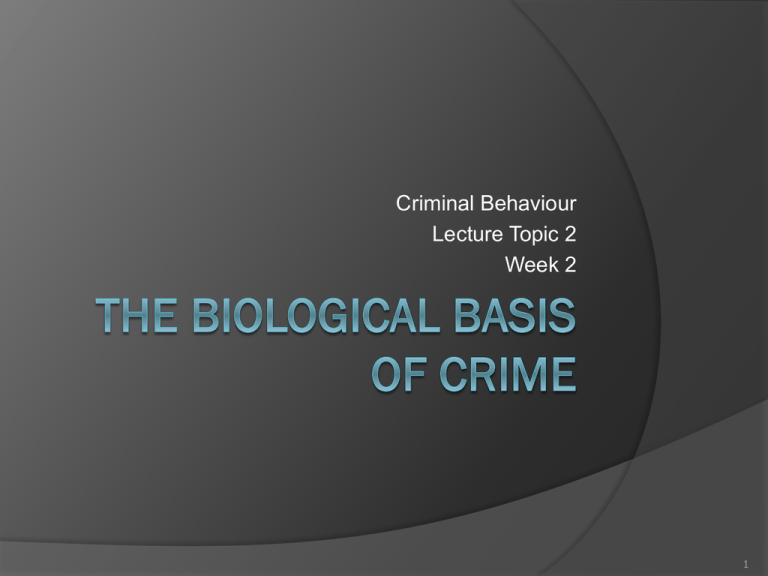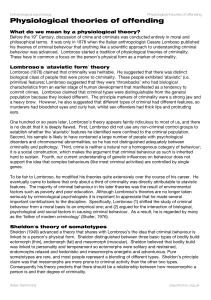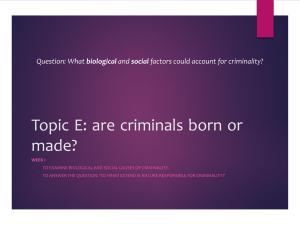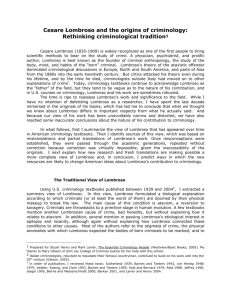
Criminal Behaviour
Lecture Topic 2
Week 2
1
Lecture Objectives
At the end of this lecture you should be
able to:
Describe biological factors
Evaluate critically the evidence for a
biological basis to crime
Describe and critique Lombroso’s &
Sheldon’s theories
Describe and critique Eysenck’s theory of
criminality
2
Biological factors include:
Genetic disposition or predisposition
Acquired deficits (birth trauma, other
head injuries) and poisons causing
permanent damage (heavy metal
poisoning)
Transient biochemical problems (drugs,
hormone imbalances)
3
Physique
Physique was thought to be the outward
sign of a criminal disposition. Includes
the theories of:
Lombroso’s Atavistic or Born Criminal
Phrenology
Sheldon’s Somatotyping
4
Darwinian influence
Remember that many of the early
biological theories were developed
shortly after the publication of Darwin’s
Origin of Species
Early theories were simplistic and relied
heavily upon the notion of evolution
(quite a naïve notion at that)
5
Lombroso’s Born Criminal
Instrumental in establishing asylums for
the criminally insane
In November 1872, Lombroso
performed an autopsy on the body of a
criminal by the name of Villella
Villella’s skull revealed an anomaly in
the cranial structure, a smooth concavity
in the occipital area described as the
median occipital fossette
6
The discovery of the fossette convinced
Lombroso that criminals are born
Lombroso considered the ‘criminal’ as a
separate species, which had not
sufficiently evolved
Lombroso termed this ‘evolutionarily
retarded species’ Homo delinquens
7
Physical Description
Homo delinquens had:
Asymmetrical skulls
Flattened noses
Large ears
Fat lips
Enormous jaws
High cheekbones
Mongolian eye characteristics
8
They also had:
An affinity for tattoos
Cruel games
Orgies
A peculiar primitive slang
Lombroso concluded that these people could
not adapt socially and morally to the
demands of the modern times.
9
“…the desire not only to extinguish life in
the victim, but to mutilate the corpse,
tear its flesh and drink its blood.”
(Lombroso’s speech at the Sixth Congress
of Criminal Anthropology)
10
Softening of Lombroso’s Theory
Over time Lombroso softened his
approach, and acknowledge that only
around 1/3 of criminals fell into the
‘atavistic’ category
For the remainder the environment was
the key factor
11
Lombroso’s Criminal Types
Born Criminal – innately antisocial
Habitual or professional Criminal –
systematic violation of law, crime as a
profession
Judicial Criminal – violated law through a
lack of prudence or forethought (impulsive)
Criminals of Passion – violated law through
honour, love, noble ambition, patriotism
Criminaloids – violated law as a result of a
weak character (easily lead astray)
12
Lombroso also acknowledged the
morally insane and the hysterical
criminal
Female offenders were originally
considered by Lombroso to “lack a
mother sense”, but later he described
them as…
More terrible and cruel than any man,
almost monsterlike – “vengeances of a
refined cruelty”
13
Phrenology
Phrenology was based on two basic
premises:
Firstly, that the brain was the organ of the
mind and that size mattered
Secondly, that the size of different areas of
the brain would be related to the shape of
the skull
14
influential at the time – the
wealthy would go and get their
bumps read!
Probably influenced Lombroso
Very
So let’s play with my Phrenology Head!
15
William Sheldon
Theory of Somatotyping (relationship
between body type and personality)
Still used today – i.e., chiropractic,
eating disorders
16
Classify yourself
For each of the following descriptions,
give yourself a score out of 7, with 1
being not at all like me to 7 being exactly
like me
17
soft body
underdeveloped muscles
round shaped
over-developed digestive system
Score from 1 (not at all like me) to
7 (exactly like me)
18
hard, muscular body
overly mature appearance
rectangular shaped
thick skin
upright posture
Score from 1 (not at all like me) to
7 (exactly like me)
19
thin
flat chest
delicate build
young appearance
tall
lightly muscled
stoop-shouldered
large brain
Score from 1 (not at all like me) to
7 (exactly like me)
20
You should now have 3 scores
If your first score is highest then you are
endomorphic
If your second score is highest then you
are mesomorphic
If your third score is highest then you
are ectomorphic
21
Let’s Group
Endomorphs Mesomorphs Ectomorphs
Here
Here
Here
22
Ectomorphic
self-conscious
preference for privacy
introverted
inhibited
socially anxious
artistic
mentally intense
emotionally restrained
23
Mesomorphic
adventurous
desire for power and dominance
courageous
indifference to what others think or want
assertive, bold
zest for physical activity
competitive
love of risk and chance
24
Endomorphic
love of food
tolerant
evenness of emotions
love of comfort
sociable
good humored
relaxed
need for affection
25
Sheldon avoided sharp distinctions between
body types – must have a 7 to be classified,
and most are somewhere in between
Achieving a 7 was unusual
Most people will have a primary body type,
for example 3-2-5 would be primarily
ectomorphic but would contain
characteristics of other body types
Average would be 4-4-4
26
The basic problem
Is your personality driven by your body
type?
Or is your body type driven by your
personality?
Sheldon attempted to overcome this
problem by basing body type on
objective measures of shoulder width
versus hip width
27
The findings…
University males typically 4-4-4
Delinquents tended to be mesomorphic
Some endomorphic delinquents
Very few ectomorphic delinquents
Modern findings refute Sheldon’s
somatotyping and its relationship with
criminality
28
Physiological Indices
29
Heart Rate & Criminality
Lower heart rate has been found
amongst criminals, delinquents and the
children of criminals compared to
controls. Findings consistent across a
range of studies (Venables,1988).
Decorated bomb disposal operators
have lower heart rate than nondecorated bomb disposal operators
which was lower than soldier controls.
30
Implications: heart rate is related to
fearlessness, criminals have a lower
level of fearlessness than non-criminals.
This could be either learnt or biological
although Venables suggests that it is
hereditary. The finding regarding
children is interesting to note though.
31
EEG Patterns and Criminality
Some evidence suggests criminals have
different electroencephalogram (EEG)
readings notably slower alpha rhythms and
slower activity generally than non-criminals.
Whatever the explanations (and there are
some tentative ones) this difference has
been found and does suggest a genetic
difference.
32
Hypoglycaemia and Criminality
Hypoglycaemia has been linked to
irritability, outbursts and aggression.
Differences in hypoglycaemia and
related conditions (insulin secretions)
found between aggressive criminals and
controls. But hypoglycaemia and
alcohol significance, since alcohol
impacts on insulin secretion. The
physiological explanations are unclear.
33
Hyperactivity
Strong relationship between ADHD and
criminality
34
Hemisphere Functioning and Criminality
Some evidence for hemispheric dysfunction
among certain offenders, specifically violent
and aggressive offenders. Research is
based on WAIS score imbalances between
the Verbal and Performance scores.
Performance is considered to be sourced in
the right hemisphere and verbal in the left.
35
The differences however could be due to
environmental differences in learning.
That is, Verbal scores are more strongly
related to academic performance than
performance scores.
Physiological measures suggest that
violent subjects have a lower left
hemisphere arousal
36
Attractiveness
Has been suggested that facial and
general physical attractiveness is lower
in criminals
Social ramifications of attractiveness
most likely explanation
Offenders who undergo cosmetic
surgery tend to have a lower recidivism
rate!
37
Minor Physical Abnormalities
MPA’s
are slightly correlated with abnormal
behaviour, including violence.
MPA’s develop during 1st trimester.
Suggested that brain abnormalities also
occur at this time.
Studies show MPA’s are predictive of violent
behaviour in those children who have poor
parenting. Strong suggestions of an
interaction effect. Not a genetic indicator.
38
Neurotransmitters
Studies
suggest reduced serotonin in antisocial
and aggressive persons with no effect for other
neurotransmitters.
Impact on suicide also an issue.
Results of studies to date suggest the need to
control for specific influences such as
alcoholism and nutrition.
Overall, there is now very strong evidence for
neuro-transmitter implications in violence.
39
Brain Dysfunction
Some brain dysfunction linked to anti-social and
violent behaviour. This is strongest for violent
offences and frontal lobe dysfunction; and
temporal lobe deficits for sex offenders.
40
Prefrontal cortex is responsible for
executive functions and executive
control – sustained attention, working
memory, abstract decision making, self
regulation and inhibition, planning and
organising. Clearly, a poor functioning
prefrontal cortex can result in poor
impulse control.
41
Brain Dysfunction
Studies are based on neuropsychological
tests and brain imaging
Conclusion: Could be acquired deficits but
may also be genetic.
Acquired brain damage is related to violent
offending.
42
Research Design
Twin Studies
Adoption
Studies
Control
Variable
Environment
Genetics
Experimental
Variable
Genetics
Environment
Note: It is ethically impossible to randomly assign
infants!
43
Twin Studies
Monozygotic
Dizygotic
Genetically Different
Genetically Identical
44
Twin Studies
Aim is to tease out genetic and environmental
effects.
Assumption: monozygotic and dizygotic twins
have some environment but different genes.
Concordance rates: probability of one twin
being criminal if the other is also. Average
concordance rate for MZ is 51.5% and for DZ
20.6%. For most recent studies 31% v
12.9%.
45
Twin Studies
Although some limitations, these tend to
introduce random error or a bias which
would reduce the effect.
46
Adoption studies
Use of cross fostering paradigm.
Compares criminality in children who have
been adopted into non-familial families.
Results shown in 2x2 design
47
Adoption studies
Adopted
Parent
Criminal
Adopted
Parent NonCriminal
Biological
Parent
Criminal
24.5%
Biological
Parent NonCriminal
14.7%
20%
13.5%
48
Conclusion
The evidence is consistently pointing a biological
basis for offending behaviours, especially violent
crime.
The biological basis could be genetic or acquired
or an interaction effect.
The evidence strongly supports a genetic predisposition to crime.
The evidence also points to a very strong
interaction effect.
49
Eysenck’s Theory
An elaborate and complex theory of
criminal behaviour. Eysenck has
combined learning theory with
psychophysiology to produce a theory that
tries to explain criminal behaviour.
He suggests that there are four main
personality dimensions:
50
Eysenck’s Theory
intelligence - related to the cerebral
cortex as a whole
extraversion/intraversion - related to the
reticular activating system
neuroticism - related to the autonomic
nervous system
And…
51
Eysenck’s Theory
psychoticism - as yet no specific brain
location – similar to psychopathy –
possible neurological basis
52
Eysenck’s Theory
Eysenck's notion of intelligence is
consistent with the G factor theories.
Extraversion refers to behaviours such as
sociability, impulsivity, high needs for
excitement and generally high needs for
excitement.
53
Extroversion
Intraversion refers to the need for quiet, for close
friends, for control.
Extraverts postulated to have overactive RAS filters out too much of the incoming information.
Consequently, they need high excitation to achieve
homoeostatic functioning. Results in excitation
seeking behaviours & thus criminal behaviour.
Intraverts - under active RAS - lets in too much
information or amplifies the information.
Consequently, stimulation avoidance since
homeostasis of cortical arousal is readily achieved.
54
Neuroticism
Neuroticism is related to the autonomic nervous
system - this system prepares the body for fight/flight
response.
High neuroticism – over-active ANS – turns on quickly
or stays on longer.
ANS over arousal leads to greater impact of stressful
and anxiety producing events.
To avoid the activation of the ANS they tend to act in
habitual behaviours. If a person has learnt antisocial
behaviours as a way of reducing the impact of the
autonomic nervous system then they are more likely
to engage in continuous antisocial acts.
55
Psychoticism
Most poorly articulated concept in
Eysenck's theory. It is very similar to
psychopathy, cold callous indifferent to the
needs of others - the opposite of altruism.
56
Criminal Behaviour
These personality predispositions interact with
one's learning history.
Eysenck suggests that conditioned fear is a
critical component of not committing crime.
That is, we do not act in antisocial ways
because these are conditioned stimuli for
conditioned fear (or anxiety). The
unconditioned stimulus is the aversive
consequence (the beatings) and the
unconditioned behaviour is the antisocial act.
57
Criminal Behaviour
ie antisocial act leads aversive consequence
leads to fear/anxiety
after several trials
antisocial act leads fear/anxiety
However, for extraverts the learning process
is much more difficult because the RAS stops
the information from being properly
synthesised.
58
Criminal Behaviour
Neuroticism result in higher levels of
habitual behaviour. Thus if a extravert has
not been properly conditioned it is likely
that they will engage in repetitive antisocial
acts.
59
The Evidence
High excitation seeking is related to criminal
behaviour.
Family violence perpetrators have overactive
ANS.
Violent offenders have higher levels of
attribution of hostile intent.
But studies using questionnaires (especially
those designed by Eysenck to measure these
attributes) have not been very supportive.
60
The Evidence
The flaws therefore, could be anywhere in the
model, from measurement problems to the
whole thing being wrong. Furthermore, the
theory does suffer from the problem of being
a general explanation for crime.
The theory may be useful for explaining why
some people commit crime but not explain all
criminal behaviour.
61
The Evidence
One of the most serious problems is the
reliance on classical conditioning. There is
no doubt that most human behaviour is not
learnt through classical conditioning. The
theory undoubtedly needs to take into
account other forms of learning.
62
Consolidation
Write down three things you remember
about these sections of the lecture
Early theories (Lombroso & Sheldon)
Twin & Adoption Studies
Personality & RAS
63












